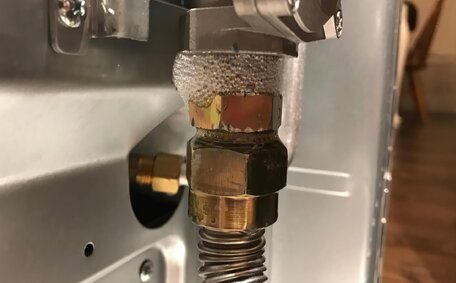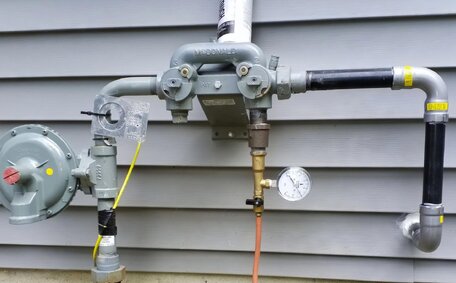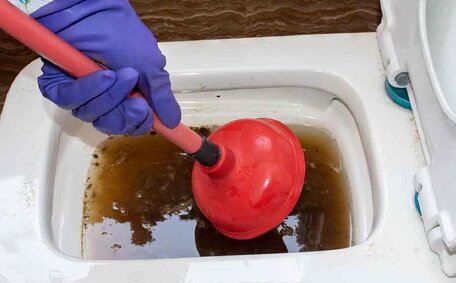Homeowners and business operators face the challenge of a blocked drain with significant disruption. Unfortunately, clogged drains are one of the most common plumbing issues. Ignoring a blocked drain can result in substantial water damage, sewage overflow, and health risks.
As a leading plumbing company serving Kenthurst and the greater Sydney area, Kenthurst Plumbing understands the urgency of blocked drain emergencies. This guide clearly outlines the do’s and don’ts for recognising and addressing blocked drains, emphasising when to seek professional help.
Within this guide, you’ll find actionable tips for managing blocked drains and discerning when it’s necessary to call Kenthurst Plumbing at 1300 349 338 for expert intervention. Our team excels at everything from preventive maintenance to emergency drain clearing, coupling the know-how with tools and experience to restore your plumbing system.
Recognizing the Signs of a Blocked Drain
Identifying a blocked drain promptly is essential to reducing damage and averting a major plumbing crisis. Key indicators of a blocked drain may include the following signs:
- Slow drainage: If sinks, showers, or toilets show water down drain moving sluggishly, a partial blockage may be forming.
- Gurgling noises: A gurgling sound from your plumbing fixtures usually suggests a drain line obstruction. Air pockets form as water attempts to pass the clog.
- Sewage odours: A foul sewage odour emanating from drains typically indicates a clog. Sewage backs up behind the blockage.
- Overflowing fixtures: Standing water in sinks or bathtubs that remains undrained often signals a severely clogged drain. Overflow leads to flooding.
- Wet spots: Water pooling around cleanout access points outdoors hints at a deeper blockage in the main sewer drain.
Act promptly upon noticing any signs of a blocked drain. Start with DIY methods like plunging. But if you suspect a severe clog or see signs of sewage backup, call Kenthurst Plumbing immediately at 1300 349 338 to prevent a small issue from becoming a costly emergency.
Causes of Blocked Drains
Various household items and substances can lead to blockages when not disposed of correctly. Awareness of potential blocking agents can help you prevent blocked drains.
Here are some of the most frequent culprits of drain blockages in homes and businesses:
- Fats, oils and grease (FOG) - Cooking residue like oil or grease solidifies on pipe walls when put down drain channels. It sticks to other debris causing a nasty clog.
- Food particles - Small scraps of fibrous foods can accumulate over time. Produce peels, eggshells and coffee grounds are prime offenders.
- Hair - Strands of hair shed in bathrooms can wind around drains and collect other gunk.
- Hygiene products - Items like cotton swabs and dental floss are not flushable. They easily snag in pipes.
- Tree roots - Invasive roots penetrate and break pipe joints, obstructing sewer lines.
- Flushable wipes - So-called flushable wipes usually don’t degrade. They cling to pipe walls and each other.
- Toys, jewellery & other foreign objects - Kids may flush toys down toilets. Dropped items like earrings can lead to significant plumbing issues.
Resist flushing non-degradable materials down your drains to avert blockages. Taking these precautions helps maintain a healthy plumbing system and prevent many frustrating drain clogs.
Immediate Steps When Facing a Blocked Drain
Assessing the Severity and Locating the Blockage
Initially, ascertain whether you’re dealing with a complete or partial blockage. Check all drains in the house to pinpoint the location. Blockages that affect the entire home likely indicate a main sewer line issue.
Shut off the water supply to fixtures connected to the blocked drain in your home. This prevents additional water from entering the clogged line and causing overflows or flooding.
When attempting to clear a drain, arm yourself with waterproof gloves, goggles, and old clothing for protection. Expect some sewage backsplash.
Contain & Clean Any Overflow
Position buckets beneath any taps that are leaking. Mop up any overflow. Disinfect any surfaces touched by sewage to prevent the spread of bacteria.
Determining the Extent and Severity of the Blockage
When facing any blocked drain issue, start by evaluating the severity of the clog to determine next steps.
Also assess if the clog is affecting a single fixture like a sink or tub, or if multiple drains in the home are blocked. System-wide backups indicate a larger problem like a blocked main line. In those cases, skip the DIY attempts and call Kenthurst Plumbing immediately at 1300 349 338.
A swift professional evaluation for significant blockages can prevent overflows and the backflow of contaminated water into your property. Our technicians have the high-power equipment to clear even the toughest clogs.
Turn Off Water Supply
Once you’ve identified a blocked drain, an important early step is to turn off the water supply to the affected fixtures. This prevents additional water from entering the clogged drain and reduces the chances of overflows or flooding.
Start by locating the main shut-off valve for the home’s water supply. The valve may be on a vertical pipe or tapping off the water main line.
Typically situated at the front of your house or in the basement, rotate this valve clockwise to stop the water flow.
If you have shut-off valves under sinks or behind toilets, you can isolate the water supply just to those fixtures. However, when in doubt, turn off the main valve.
Switching off the water gives you time to address the clog without more water draining. It also limits water damage if sewage backs up from the blockage. Be sure to turn the water back on slowly once the drain is cleared to check for leaks.
Wear Protective Equipment
When tackling any blocked drain issue, its essential to wear appropriate protective gear to safeguard yourself against health hazards and stay clean.
Prior to addressing a drain blockage, ensure you have the following items:
- Thick rubber gloves that cover the forearms - These shield against contaminated water and debris.
- Protective eyewear like goggles - Safety glasses prevent sewage splashes to the eyes.
- Waterproof boots or shoes - Wear footwear that can withstand getting wet and dirty.
- Face mask - A mask protects against bacteria from sewage and foul odours.
- Waterproof overalls - Wear full protective overalls over your clothes to keep them clean.
Do not attempt to unclog drains without wearing suitable protective gear. Blockages often contain toxic substances, faecal matter, and pathogens that can cause illness. Take safety precautions.
Equipped with the right gear, you can work swiftly and effectively, reducing mess and exposure risks. To reduce risk, always use waterproof gloves, goggles, masks, and protective garb when dealing with blocked drains.
Contain any Overflow
Should a blocked drain cause water to overflow from fixtures, act quickly to manage the spill and minimise damage. Wipe and disinfect any surfaces that came into contact with sewage contaminated water to prevent bacteria spreading.
Place towels, rags, or buckets around affected fixtures to catch the overflow. Use a wet/dry vacuum to remove pooled water on floors.
For major overflows, shut off the water supply to isolate the issue while working to clear the blockage. Contact Kenthurst Plumbing as soon as possible for an emergency plumber to stop the overflow and manage drain clearing services.
Utilise sandbags or other water barriers to redirect outdoor drainage away from the home. Our technicians have the powerful hydro jetting equipment to quickly clear blockages and stop additional flooding damage inside and outside the property.
Unclogging a Blocked Drain Yourself
Homeowners tend to attempt clearing a blocked drain on their own before seeking professional help. Basic DIY techniques may resolve minor sink or tub clogs, but extreme caution is needed for fully blocked main lines.
Here are some common remedies for unclogging drains yourself:
- Plunger - Place the plunger firmly over the drain and plunge up and down rapidly to dislodge clogs.
- Baking Soda and Vinegar - Pour half a cup of baking soda down the drain, followed by half a cup of vinegar. Cover and let fizz for 5-10 minutes then rinse with hot water.
- Wire Hanger - Use a straightened wire hanger to hook and extract hair, gunk, and other debris causing a clog.
Avoid aggressive chemical drain cleaners to protect pipes from damage and prevent the release of harmful fumes. For relentless or overflow-causing blockages, don’t hesitate to reach out to Kenthurst Plumbing at 1300 349 338; our licensed technicians are ready to effectively and safely clear the obstruction.
Homeowners tend to attempt clearing a blocked drain on their own before seeking professional help.
Using a Plunger
A plunger can effectively clear minor clogs in sinks, tubs, and toilets by creating an airtight seal over the drain. By pumping the plunger, you generate the suction needed to dislodge the clog.
Plunge rhythmically without pulling too far up and breaking the seal. Add more water if needed while plunging to increase the pressure on the clog. You may need to repeat the plunging process several times.
Flush the toilet or run fresh hot water down the drain after plunging to rinse away dislodged debris. Flush the toilet or run fresh hot water down the drain after plunging to rinse away dislodged debris.
Take care not to use too much force while plunging, which can damage pipes. Only use a plunger on partially blocked sinks or toilets, not on completely clogged systems. For professional drain clearing services, contact Kenthurst Plumbing at 1300 349 338.
A simple plunger can effectively clear minor sink, tub, and toilet clogs. First, fill the blocked basin with enough water to cover the drain opening entirely.
Baking Soda and Vinegar
A simple homemade drain cleaner can be made with baking soda and vinegar. Start by pouring 12 cup of baking soda down the blocked drain. Start by pouring 12 cup of baking soda down the blocked drain. Start by pouring 12 cup of baking soda down the blocked drain. This chemical reaction helps break down organic matter like food scraps, oils and hair.
Next, pour 1 cup of heated white vinegar down the drain.
Cover the drain tightly after adding the vinegar. Cover the drain tightly after adding the vinegar. Let the mixture sit for 5-10 minutes before rinsing with hot water. Let the mixture sit for 5-10 minutes before rinsing with hot water.
Take care not to use this method after trying harsh chemical drain cleaners, as it can result in dangerous chemical reactions.
The non-toxic combination of baking soda and vinegar provides an effective eco-friendly solution for clearing minor sink and tub drain clogs yourself. But for complete blockages or overflowing drains, call Kenthurst Plumbing immediately at 1300 349 338.
Using a Wire Hanger
For drains clogged with hair and gunk, a wire hanger can be a handy tool for removing the debris.
Start by straightening out the hanger. Next, bend one end to create a small hook shape. Insert the hanger into the drain opening and twist gently, ensnaring any hair and debris. Slowly pull the hanger out, bringing the clogging mass with it. Run hot water for a few minutes to rinse away any residue. You may need to repeat this process several times to clear stubborn hair clogs.
Take care not to scratch your fixtures with the wire hanger when inserting it. Wear gloves to protect your hands. Do not use this method on completely blocked drains, as it cannot solve severe clogs. Contact Kenthurst Plumbing at 1300 349 338 instead for professional drain clearing services.
When to Call a Professional Plumber
While minor drain clogs can often be cleared with basic DIY methods, more severe blockages require professional equipment and expertise. Here are some scenarios where you should call a licenced plumber rather than attempting to fix the issue yourself:
- Multiple drains in the home are completely blocked
- You are unable to determine the location or cause of the clog
- DIY attempts with a plunger, baking soda/vinegar or wire hanger have failed
- Sewage is overflowing from drains or fixtures
- Outdoor cleanouts are overflowing and water is pooling, which poses a hazard to the vicinity of your home
- Slow drainage persists after trying to clear the clog yourself
- Drain line blockages that may require access to piping under the home
Attempting to snake or hydro jet main sewage lines on your own can be ineffective and cause pipe damage. Our professional team at Kenthurst Plumbing have the specialised equipment like CCTV cameras to accurately locate clogs.
We can hydro jet blockages that even drain augers cannot clear. We can hydro jet blockages that even drain augers cannot clear.
For fast, affordable plumbing services, especially drain clearing, call Kenthurst Plumbing at 1300 349 338. We are available 24/7 to handle any blocked drain emergency and prevent costly water damage to your property.
While minor drain clogs can often be cleared with basic DIY methods, more severe blockages require professional equipment and expertise.
Multiple drains in the home are completely blockedYou are unable to determine the location or cause of the clogDIY attempts with a plunger, baking soda/vinegar or wire hanger have failedPreventing Future Blocked Drains
Preventing bl before it enters the pipe.
Avoid pouring fats, oils, and grease down the sink - collect in a container and dispose of properly.Throw food scraps in the trash rather than the garbage disposal to reduce buildup.Don’t flush anything except human waste and toilet paper - no wipes or other items.Use a drain cleaner monthly to break up grease and keep pipes clear.Trim any trees/shrubs near exterior pipes to prevent invasive roots.Have a professional plumber inspect and clear main sewer pipes annually.Following these simple precautions keeps drains free of obstructions. Catching minor clogs early prevents major backups and damage. For professional drain inspections and cleaning, contact Kenthurst Plumbing at 1300 349 338 - our preventive maintenance services keep plumbing systems operating smoothly.
Stay vigilant against blocked drains by monitoring water flow and responding quickly to any gurgling or slow drainage. Our team is here to help with any persistent clogs. Don’t wait until it’s an emergency - call Kenthurst Plumbing today to prevent problems down the line.
Avoid Grease Buildup
Grease and oil buildup is one of the most preventable causes of blocked drains. Cooking oils, fats, and grease should never be poured down the sink drain. Over time, this causes a nasty clog.
As grease cools, it congeals and sticks to the sides of pipes, trapping food particles and other debris.
The best way to avoid grease buildup is to contain and dispose of oils and fats separately. Pour excess grease from pans into a heat-safe container and let it solidify. Throw away solidified grease in the garbage rather than rinsing it down the drain. Pour excess grease from pans into a heat-safe container and let it solidify.
Scrape plates and cookware to remove fats before washing.
Take steps to keep grease out of your plumbing. Following these tips prevents pipes clogging up with thick, sticky grease that is difficult to clear.
Avoid pouring meat juices, bacon fat, cooking oil, shortening, butter, salad dressings, gravy, or cheese sauces down the drain. Contact Kenthurst Plumbing at 1300 349 338 if your drains are sluggish due to grease buildup - our team has the expertise to restore proper flow.
Use Drain Screens
Installing drain screens or strainers over sink, shower, and tub drains provides an easy preventive measure against clogs. These screens trap hair, food particles, and other debris before it goes down the drain. This keeps solid objects from entering pipes where they could accumulate and cause a blockage.
Sink strainers can be placed over the drain opening inside the sink basin. Many strainers twist in place to secure them. Drain screens should be cleaned off regularly when buildup is noticed to keep water flowing freely.
For tubs and showers, hair catchers can also be attached right over the drain cover to block strands before they circle the pipes.
Using drain screens helps prevent many common clogging issues. Hair, grease, and food scraps are caught by the screen rather than entering pipes.
However, drain screens don’t protect against other causes of blockages like mineral deposits or roots growing into sewer lines. Contact Kenthurst Plumbing at 1300 349 338 for professional drain inspections and cleaning services as part of your ongoing maintenance routine.
Installing drain screens or strainers over sink, shower, and tub drains provides an easy preventive measure against clogs.






